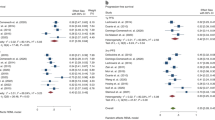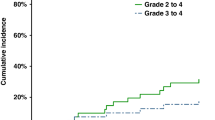Abstract
Background
Allogeneic hematopoietic stem cell transplantation (allo-HSCT) is a potentially curative treatment option in advanced-stage mycosis fungoides (MF) and Sézary syndrome (SS). This study presents an updated analysis of the initial experience of the Lymphoma Working Party of the European Society for Blood and Marrow Transplantation (EBMT) describing the outcomes after allo-HSCT for MF and SS, with special emphasis on the impact of the use of unrelated donors (URD).
Methods and patients
Eligible for this study were patients with advanced-stage MF or SS who underwent a first allo-HSCT from matched HLA-identical related or URD between January/1997 and December/2011. Sixty patients have been previously reported.
Results
113 patients were included [77 MF (68%)]; 61 (54%) were in complete or partial remission, 86 (76%) received reduced-intensity protocols and 44 (39%) an URD allo-HSCT. With a median follow up for surviving patients of 73 months, allo-HSCT resulted in an estimated overall survival (OS) of 38% at 5 years, and a progression-free survival (PFS) of 26% at 5 years. Multivariate analysis demonstrated that advanced-phase disease (complete remission/partial remission >3, primary refractory or relapse/progression in patients that had received 3 or more lines of systemic treatment prior to transplant or the number of treatment lines was not known), a short interval between diagnosis and transplant (<18 months) were independent adverse prognostic factors for PFS; advanced-phase disease and the use of URDs were independent adverse prognostic factors for OS.
Conclusions
This extended series supports that allo-HSCT is able to effectively rescue over one third of the population of patients with advanced-stage MF/SS. High relapse rate is still the major cause of failure and needs to be improved with better strategies before and after transplant. The negative impact of URD is a matter of concern and needs to be further elucidated in future studies.
Highlights
-
Allogeneic transplantation is a potentially curative option for advanced-stage mycosis fungoides and Sézary syndrome.
-
Advanced-phase disease constitutes the most important prognostic factor for the long term outcome of the patients.
-
The negative impact of the use of unrelated donors needs to be further elucidated.
This is a preview of subscription content, access via your institution
Access options
Subscribe to this journal
Receive 12 print issues and online access
$259.00 per year
only $21.58 per issue
Buy this article
- Purchase on Springer Link
- Instant access to full article PDF
Prices may be subject to local taxes which are calculated during checkout




Similar content being viewed by others
References
Weinstock MA, Gardstein B. Twenty-year trends in the reported incidence of mycosis fungoides and associated mortality. Am J Public Health. 1999;89:1240–4.
Bradfort PT, Devesa SS, Anderson WF, Toro JR. Cutaneous lymphoma incidence patterns in the United States: a population-based study of 3884 cases. Blood. 2009;113:5064–73.
Wilcox RA. Cutaneous B-cell lymphomas: 2016 update on diagnosis, risk-stratification, and management. Am J Hematol. 2016;91:1052–5.
Agar NS, Wedgeworth E, Crichton S, Mitchell TJ, Cox M, Ferreira S, et al. Survival outcomes and prognostic factors in mycosis fungoides/Sézary syndrome: validation of the revised International Society for Cutaneous Lymphomas/European Organisation for Research and Treatment of Cancer staging proposal. J Clin Oncol. 2010;28:4730–9.
Benton EC, Crichton S, Talpur R, Agar NS, Fields PA, Wedgeworth E, et al. A cutaneous lymphoma international prognostic index (CLIPi) for mycosis fungoides and Sezary syndrome. Eur J Cancer. 2013;49:2859–68.
Duarte RF, Schmitz N, Servitje O, Sureda A. Haematopoietic stem cell transplantation for patients with primary cutaneous T-cell lymphoma. Bone Marrow Transpl. 2008;41:597–604.
Molina A, Zain J, Arber DA, Angelopolou M, O’Donnell M, Murata-Collins J, et al. Durable clinical, cytogeneic, and molecular remissions after allogeneic hematopoietic cell transplantation for refractory Sézary syndrome and mycosis fungoides. J Clin Oncol. 2005;23:6163–71.
Duarte RF, Canals C, Onida F, Gabriel IH, Arranz R, Arcese W, et al. Allogeneic Hematopoietic cell transplantation for patients with mycosis fungoides and Sézary syndrome: a retrospective analysis of the lymphoma working party of the European Group for Blood and Marrow Transplantation. J Clin Oncol. 2010;28:4492–9.
Lechowicz MJ, Lazarus HM, Carreras J, Laport GG, Cutler CS, Wiernik PH, et al. Allogeneic hematopoietic cell transplantation for mycosis fungoides and Sezary síndrome. Bone Marrow Transpl. 2014;49:1360–5.
Duarte RF, Boumendil A, Onida F, Gabriel I, Arranz R, Arcese W, et al. Long-term outcome of allogeneic hematopoietic cell transplantation for patients with mycosis fungoides and Sézary syndrome: a European society for blood and marrow transplantation lymphoma working party extended analysis. J Clin Oncol. 2014;32:3347–8.
Burt RK, Guitart J, Traynor A, Link C, Rosen S, Pandolfino T, et al. Allogeneic hematopoietic stem cell transplantation for advanced mycosis fungoides: evidence of graft-versus-tumor effect. Bone Marrow Transpl. 2000;25:111–3.
Herbert KE, Spencer A, Grigg A, Ryan G, McCormack C, Prince HM. Graft-versus-lymphoma effect in refractory cutaneous T-cell lymphoma after reduced-intensity HLA-matched sibling allogeneic stem cell transplantation. Bone Marrow Transpl. 2004;34:521–5.
Gabriel IH, Olavarria E, Jones RR, Whittaker S, Chaidos A, Apperley JF. Graft versus lymphoma effect after early relapse following reduced-intensity sibling allogeneic stem cell transplantation for relapsed cytotoxic variant of mycosis fungoides. Bone Marrow Transpl. 2007;40:401–3.
Duvic M, Donato M, Dabaja B, Richmond H, Singh L, Wei W, et al. Total skin electron beam and non-myeloablative allogeneic hematopoietic stem-cell transplantation in advanced mycosis fungoides and Sezary syndrome. J Clin Oncol. 2010;28:2365–72.
Polansky M, Talpur R, Daulat S, Hosing C, Dabaja B, Duvic M. Long-term complete responses to combination therapies and allogeneic stem cell transplants in patients with Sézary syndrome. Clin Lymphoma Myeloma Leuk. 2015;15:83–93.
Hosing C, Bassett R, Dabaja B, Talpur R, Alousi A, Ciurea S, et al. Allogeneic stem-cell transplantation in patients with cutaneous lymphoma: updated results from a single institution. Ann Oncol. 2015;26:2490–5.
de Masson A, Beylot-Barry M, Bouaziz JD, Peffault de Latour R, Aubin F, Garciaz S, et al. Allogeneic stem cell transplantation for advanced cutaneous T-cell lymphomas: a study from the French Society of Bone Marrow Transplantation and French Study Group on Cutaneous Lymphomas. Haematologica. 2014;99:527–34.
Shiratori S, Fujimoto K, Nishimura M, Hatanaka KC, Kosugi-Kanaya M, Okada K, et al. Allogeneic hematopoietic stem cell transplantation following reduced-intensity conditioning for mycosis fungoides and Sezary syndrome. Hematol Oncol. 2016;34:9–16.
Mori T, Shiratori S, Suzumiya J, Kurokawa M, Shindo M, Naoyuki U, et al. Outcome of allogeneic hematopoietic stem cell transplantation for mycosis fungoides and Sézary syndrome. Hematol Oncol. 2020;38:266–71.
Bunn PA Jr, Lamberg SI. Report of the committee on staging and classification of cutaneous T-cell lymphoma. Cancer Treat Rep. 1979;63:725–8.
Olsen E, Vonderheid E, Pimpinelli N, Willemze R, Kim Y, Knobler R, et al. Revisions to the staging and classification of mycosis fungoides and Sézary syndrome: A proposal of the International Society for Cutaneous Lymphomas (ISCL) and the cutaneous lymphoma task force of the European Organization of Research and Treatment of Cancer (EORTC). Blood. 2007;110:1713–22.
Bacigalupo A, Ballen K, Rizzo D, Giralt S, Lazarus H, Ho V, et al. Defining the intensity of conditioning regimens: working definitions. Biol Blood Marrow Transpl. 2009;15:1628–33.
Przepiorka D, Weisdorf D, Martin P, Klingemann HG, Beatty P, Hows J, et al. Consensus conference on acute GVHD grading. Bone Marrow Transpl. 1994;1995:825–8.
Dietrich S, Dreger P, Hermine O, Kyriakou C, Montoto S, Robinson S, et al. Haploidentical stem cell transplantation for patients with lymphoma: a position statement from the Lymphoma Working Party-European Society for Blood and Marrow Transplantation. Bone Marrow Transpl. 2020;55:317–24.
Sureda A, Robinson S, Canals C, Carella AM, Boogaerts MA, Caballero D, et al. Reduced-intensity conditioning compared with conventional allogeneic stem-cell transplantation in relapsed or refractory Hodgkin’s lymphoma: an analysis from the Lymphoma Working Party of the European Group for Blood and Marrow Transplantation. J Clin Oncol. 2008;26:456–62.
Prince HM, Kim YH, Horwitz SM, Dummer R, Scarisbrick J, Quaglino P, et al. Brentuximab vedotin or physician’s choice in CD30-positive cutaneous T-cell lymphoma (ALCANZA): an international, open-label, randomised, phase 3, multicentre trial. Lancet. 2017;390:555–66.
Kim YH, Bagot M, Pinter-Brown L, Rook AH, Porcu P, Horwitz SM, et al. Mogamulizumab versus vorinostat in previously treated cutaneous T-cell lymphoma (MAVORIC): an international, open-label, randomized, controlled phase 3 trial. Lancet Oncol. 2018;19:1192–204.
Duvic M, Pinter-Brown LC, Foss FM, Sokol L, Jorgensen JL, Challagundla P, et al. Phase ½ study of mogamulizumab, a defucosylated anti-CCR4 antibody, in previously treated patients with cutaneous T-cell lymphoma. Blood. 2015;125:1883–9.
Khodadoust M, Rook AH, Porcu P, Foss F, Moskowitz AJ, Shustov A, et al. Pembrolizumab for treatment of relapsed/refractory mycosis fungoides and sezary syndrome: clinical efficacy in a CTN multicenter phase 2 study. Blood. 2016;128:181.
Hegerova L, Cao Q, Lazaryan A, McClune BL, Weisdorf DJ, Brunstein CG, et al. Improving outcomes after allogeneic hematopoietic cell transplantation for Hodgkin lymphoma in the brentuximab vedotin era. Bone Marrow Transplant. 2017;52:697–703.
Bazarbachi A, Boumendil A, Finel H, Mohty M, Castagna L, Peggs KS, et al. Brentuximab vedotin prior to allogeneic stem cell transplantation in Hodgkin lymphoma: a report from the EBMT Lymphoma Working Party. Br J Haematol. 2018;181:86–96.
Dreger P, Michallet M, Bosman P, Dietrich S, Sobh M, Boumendil A, et al. Ibrutinib for bridging to allogeneic hematopoietic cell transplantation in patients with chronic lymphocytic leukemia or mantle cell lymphoma: a study by the EBMT Chronic Malignancies and Lymphoma Working Parties. Bone Marrow Transplant. 2019;54:44–52.
Genadieva-Stavrik S, Boumendil A, Dreger P, Peggs K, Briones J, Corradini P, et al. Myeloablative versus reduced intensity allogeneic stem cell transplantation for relapsed/refractory Hodgkin’s lymphoma in recent years: a retrospective analysis of the Lymphoma Working Party of the European Group for Blood and Marrow Transplantation. Ann Oncol. 2016;27:2251–7.
Acknowledgements
The authors acknowledge all collaborating EBMT Investigators and Institutions that contributed cases to this study.
Author information
Authors and Affiliations
Corresponding author
Ethics declarations
Conflict of interest
The authors declare that they have no conflict of interest.
Additional information
Publisher’s note Springer Nature remains neutral with regard to jurisdictional claims in published maps and institutional affiliations.
Rights and permissions
About this article
Cite this article
Domingo-Domenech, E., Duarte, R.F., Boumedil, A. et al. Allogeneic hematopoietic stem cell transplantation for advanced mycosis fungoides and Sézary syndrome. An updated experience of the Lymphoma Working Party of the European Society for Blood and Marrow Transplantation. Bone Marrow Transplant 56, 1391–1401 (2021). https://doi.org/10.1038/s41409-020-01197-3
Received:
Revised:
Accepted:
Published:
Issue Date:
DOI: https://doi.org/10.1038/s41409-020-01197-3
This article is cited by
-
Allogeneic stem cell transplant for treatment of mycosis fungoides and Sezary syndrome: a systematic review and meta-analysis
Bone Marrow Transplantation (2024)
-
Long term outcomes of nonmyeloablative allogeneic stem cell transplantation with TSEB TLI and ATG for Mycosis Fungoides and Sezary Syndrome
Bone Marrow Transplantation (2024)
-
What Is New in Cutaneous T Cell Lymphoma?
Current Oncology Reports (2023)
-
Long-term outcomes for allogeneic bone marrow transplantation in Sezary syndrome and mycosis fungoides
Bone Marrow Transplantation (2022)
-
Allogeneic transplantation in Cutaneous T-cell Lymphoma: improved outcomes associated with early transplantation and acute graft versus host disease
Bone Marrow Transplantation (2022)



